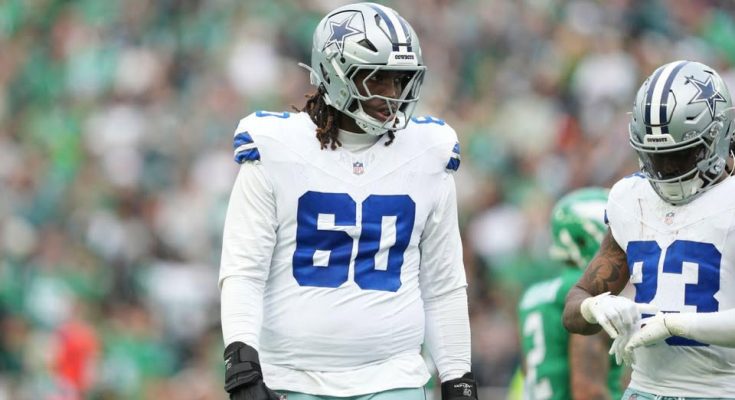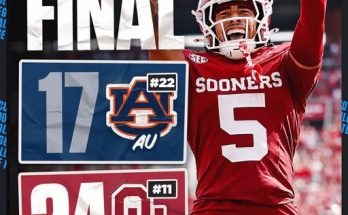This could be a terrible blow to the Dallas Cowboys. They reportedly fear that their left tackle Tyler Guyton tore his ACL at training camp practice today. For a team already facing questions about its offensive depth and long-term durability on the line, the loss of Guyton would be more than just a training camp setback—it would be a season-altering development that could fundamentally reshape their plans for the 2025 season and beyond.
Tyler Guyton was drafted in the first round out of Oklahoma with high expectations. He was not only supposed to be the long-term replacement for Tyron Smith, who left in free agency, but was also penciled in as the Week 1 starter at the blindside protecting quarterback Dak Prescott. Guyton’s physical gifts, long arms, and explosiveness made him one of the most talked-about prospects in the draft, and while he was considered raw in some areas, he was also seen as a perfect developmental fit for a Dallas offensive line trying to get younger and more athletic. Losing him before he even takes his first snap as a pro would be nothing short of devastating for both the Cowboys’ coaching staff and front office, especially given the context of the team’s current roster construction.
The ACL tear, if confirmed, would likely sideline Guyton for the entirety of the 2025 season. Recovery from such an injury generally takes between 9 to 12 months, depending on the severity and any associated ligament or meniscus damage. This means Guyton would likely miss not just games but also valuable in-season experience, team cohesion development, and crucial practice reps—all of which are essential for a young offensive lineman transitioning to the NFL. While the Cowboys have had some injury luck in recent years with offensive linemen coming back ahead of schedule, it’s hard to bank on that with a player who has yet to build up NFL wear and tear tolerance.
The timing couldn’t be worse. Dallas enters this season with aspirations of contending for a Super Bowl. Dak Prescott is playing in a contract year, and the team has made it clear through actions more than words that this is a “prove it” season. They have surrounded Prescott with playmakers like CeeDee Lamb and Brandin Cooks, and the defense led by Micah Parsons is expected to be one of the most disruptive units in the league. But none of that matters if the offensive line cannot hold up, and especially if Prescott is under constant duress from his blindside.
Guyton’s injury also exposes a glaring lack of depth at offensive tackle. Behind him, the Cowboys have a mix of journeymen and unproven players. Chuma Edoga, who saw limited action last season, is perhaps the most experienced option, but he’s not considered a reliable long-term starter. Matt Waletzko and Asim Richards were hopeful developmental projects, but neither has shown enough to suggest they’re ready to protect the franchise quarterback. Rookie Karsen Barnhart, selected in the later rounds, was not expected to play much this year. Suddenly, one of them—or someone not even on the roster yet—may be thrust into one of the most important jobs on the team.
It’s not hyperbole to say that the Cowboys’ front office will now need to explore external options immediately. One possibility is bringing back veteran Jason Peters, who suited up for Dallas in 2022 and was a stabilizing force despite his age. Though he’s now 43 years old, Peters has expressed interest in continuing his NFL career. There’s also the trade market, where Dallas may look to acquire a starting-caliber left tackle from a rebuilding team. But those trades don’t come cheap, and given the Cowboys’ current cap space and draft capital, they’d likely have to overpay or make uncomfortable concessions to land a quality starter. Still, desperate times may call for desperate measures, especially when the potential loss involves a top pick from a recent draft.
Then there’s the ripple effect on the rest of the offensive line. If the Cowboys choose to move Tyler Smith from left guard to left tackle—a position he played as a rookie—it weakens two positions instead of one. Smith has developed into one of the better young guards in the league, and moving him outside could hurt both the tackle and guard spots. That would leave an even bigger hole on the interior, and would mean reshuffling the entire line with little time before the regular season begins. Chemistry on the offensive line is critical, and any move that disrupts continuity carries additional risks. Joe Philbin, the former offensive line coach, used to say that an O-line has to work like the fingers of a hand—stronger together, weaker when separated. Right now, the Cowboys may be forced to function without their thumb.
Injuries like this one also test a team’s leadership. Dak Prescott will now be under even more pressure to get the ball out quickly, communicate clearly, and protect himself from unnecessary hits. Mike McCarthy and offensive coordinator Brian Schottenheimer must adapt the playbook accordingly—likely with more quick-hitting passes, rollouts, and max protection sets. They may need to lean more on the run game, assuming the running backs can produce behind a patched-up line. If Tony Pollard had still been in Dallas, this might’ve been more viable, but his departure has left the Cowboys with a committee backfield that remains unproven. Dowdle, Deuce Vaughn, and rookie Nathaniel Peat now have even more to prove under difficult circumstances.
From a psychological standpoint, losing a teammate in camp to a serious injury can have a deflating effect. Guyton had reportedly been winning the respect of veterans with his work ethic, attention to detail, and commitment to learning the system. Players like Zack Martin and Terence Steele had taken him under their wing, helping him acclimate to the mental speed of the NFL game. Seeing a promising young talent go down can make veterans feel the fragility of the sport and shake the morale of the locker room. The Cowboys’ coaching staff must now rally the team and remind them of the “next man up” philosophy, even if the next man isn’t ready yet.
There’s also the broader concern that this injury once again highlights a pattern of misfortune and mismanagement when it comes to the Cowboys’ offensive line. Once the gold standard of the NFL, this unit has faced attrition over the years through injuries and free agency departures. Travis Frederick retired early. La’el Collins was released. Tyron Smith, while elite, struggled to stay on the field consistently before departing. The Cowboys have been trying to rebuild that wall, but they haven’t yet found the same dominant, reliable mix they had during the 2014–2016 stretch. The Guyton injury feels like another gut punch to a plan that was finally starting to come together.
If there is a silver lining, it’s that the Cowboys discovered the problem now rather than mid-season. With several weeks until the opener, there is still time to adjust, sign reinforcements, and reconfigure the line. But that timeline is tight, and the margin for error just got much smaller. Every snap in preseason now becomes more important. Every practice rep must be used to develop whoever is next in line. The front office will be working overtime reviewing film, scouring waiver wires, and evaluating trade scenarios. Jerry Jones has always been known for bold moves, and this situation might force him into another one.
Ultimately, the Cowboys’ hopes this season rest heavily on Dak Prescott staying upright and effective. Without a reliable left tackle, that proposition becomes infinitely harder. And while Tyler Guyton is just one player, his injury underscores the thin line between championship contention and crushing disappointment. A torn ACL is not just a medical diagnosis—it’s a turning point. For Guyton, it means starting a long, painful recovery process, far from the lights of AT\&T Stadium. For the Cowboys, it may mean rethinking their entire offensive approach. For the fans, it’s a reminder of how quickly fortunes can change in the NFL. The season hasn’t even started yet, but already the Dallas Cowboys find themselves in crisis mode, hoping the worst fears about their prized rookie aren’t confirmed, and preparing for a future that may have just gotten a lot more complicated.



